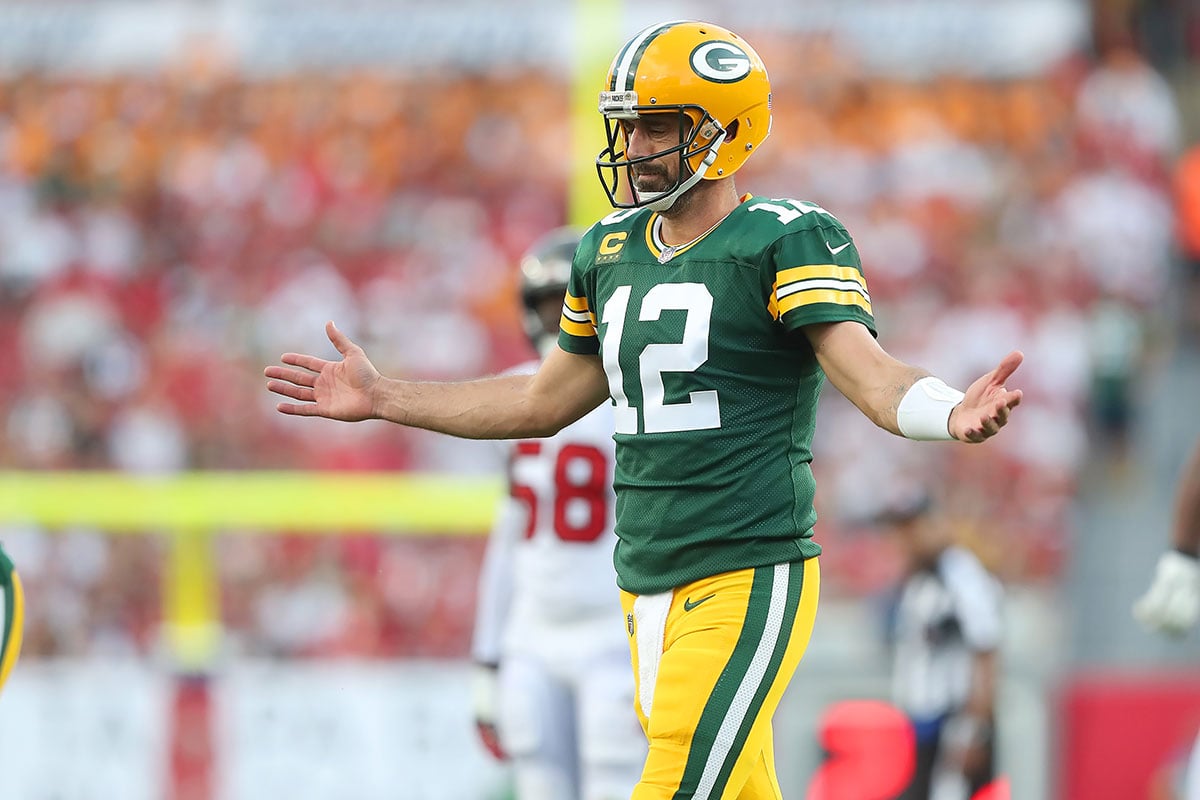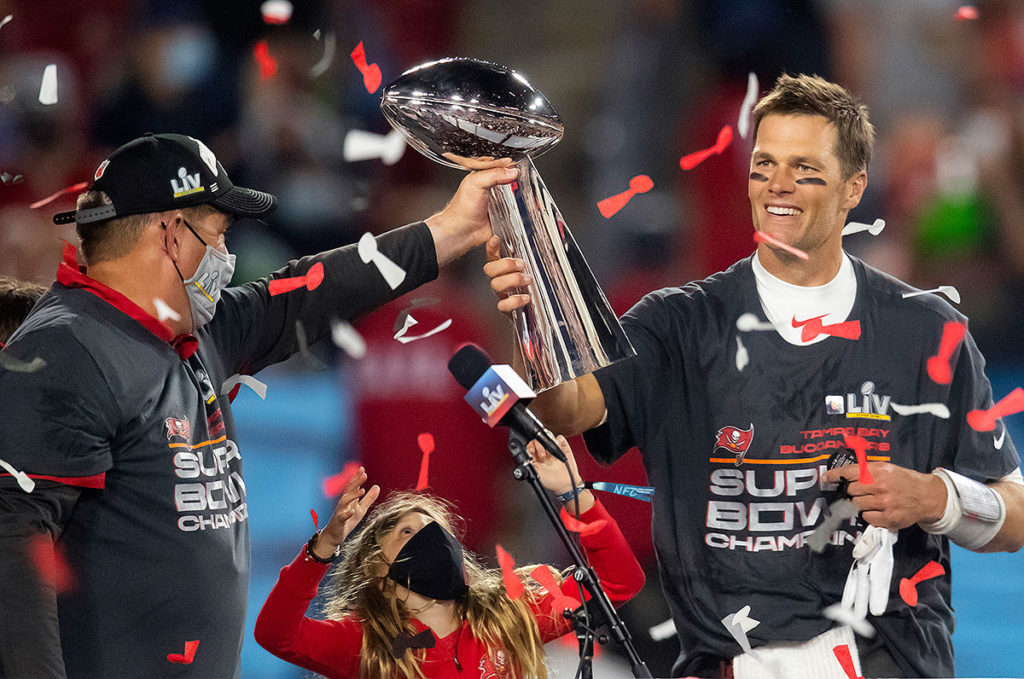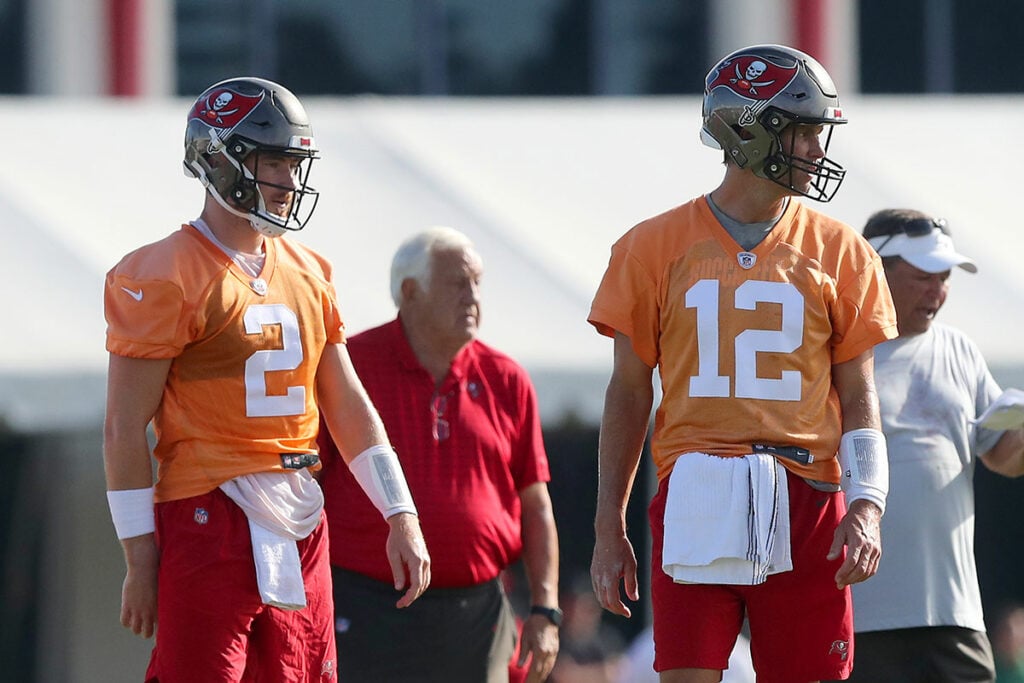Tom Brady has retired (we think). The Bucs still feature a strong roster full of young, talented players. Antoine Winfield Jr., Tristan Wirfs, Chris Godwin, Cade Otton, Rachaad White, Devin White, Joe Tryon-Shoyinka, and Carlton Davis make up a core that, with the right quarterback can still be a playoff team, especially coming out of the NFC South.
But with Brady’s retirement that last part becomes a very big question mark. Will the Bucs roll with third-year quarterback Kyle Trask? Will they attempt to secure a new face-of-the-franchise with their 19th overall pick in the 2023 NFL Draft? Could they trade up?
Looking at the state of free agency there aren’t many options that look enticing. Lamar Jackson and Geno Smith, and Daniel Jones headline the potential class, but all three of them are likely to be retained by their 2022 teams through mechanisms that will prevent them from reaching the free agent market. Beyond them, the market turns quickly to reclamation projects like Sam Darnold and Baker Mayfield. The prospects of securing a reliable signal caller via free agency aren’t great.
With free agency and the draft both crap shoots, the Bucs may find that trading for a veteran quarterback is the best course of action. Two of the hottest names being thrown around in the quarterback trade market are that of Aaron Rodgers and Derek Carr. But with the Bucs currently set to be $55 million over the 2023 salary cap could they even afford either of these talented and expensive options?
Step One: The Bucs Must Become Cap Compliant
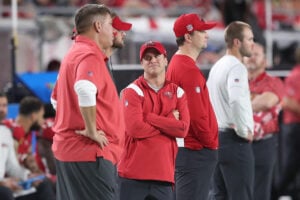
Bucs GM Jason Licht and VP of football administration Mike Greenberg – Photo by: Cliff Welch/PR
Prior to even considering bringing on either of these quarterbacks and absorbing their salaries they have to be cap compliant with their current players and commitments. So, the team’s first course of action is to find a way to trim $55 million in cap charges.
It will most likely start with them processing Brady’s retirement after June 1. That will drop the overage to $31 million. You can most likely count on them restructuring the contracts of wide receiver Chris Godwin, defensive tackle Vita Vea, and cornerback Carlton Davis III. That could free up as much as $29.5 million.
Add in likely cuts of tight end Cameron Brate, running back Leonard Fournette, kicker Ryan Succop – and possibly parting ways with left tackle Donovan Smith – and the team could create another $18.7 million in space. At that point the team would be roughly $17 million under the salary cap. Then the Bucs could realistically begin to entertain the option of taking on their second consecutive big-money quarterback.
Bucs QB Target 1: Packers QB Aaron Rodgers
Aaron Rodgers has one of the most complicated contracts in the NFL. He also represents the most talented quarterback that is firmly on the market at this point. The cost for Rodgers would be very high in terms of both draft picks and long-term salary commitments. But the short-term cap cost of acquiring the long-time Packers quarterback would be relatively light.
If the Bucs were to pursue a trade for the 39-year old Rodgers, they would first have to come to terms with Green Bay on a trade package that would convince Packers general manager Brian Gutekunst to let Rodgers go to an in-conference foe. That package would most likely take its cues from last year’s Deshaun Watson and Russell Wilson trades.
Watson was traded from Houston to Cleveland for the 13th overall pick in the 2022 draft, first-round picks in the 2023 and 2024 drafts, as well as a 2023 third-round pick and 2024 fourth-round pick. They sent a 2024 fifth-round pick back to the Browns as a part of the exchange.
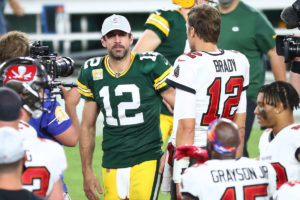
Bucs QB Tom Brady and Packers QB Aaron Rodgers – Photo by: USA Today
The Broncos gave up the ninth overall, 41st overall and 153rd overall picks in the 2022 draft, as well as first- and second-round picks in 2023, plus a gaggle of players including tight end Noah Fant, defensive lineman Shelby Harris and quarterback Drew Lock in exchange for Wilson and a fourth-round pick.
Considering the context of those trades the Bucs would certainly have to part ways with their first- and second-rounders this year, as well as their first- and second-round picks in 2024. To match the value Houston received for Watson last year using the Jimmy Johnson trade value chart the Bucs would need to give up those four picks while also getting back Green Bay’s fourth-round pick with Rodgers.
As far as the salary cap implications the Bucs would have to exercise an option bonus that is currently tied to Rodgers 2023 salary. In doing so they would convert $58.3 million of his $59.515 million salary into a prorated bonus that is currently spread out over four years. The result would be a cap charge that totals just $15,790,000 which the team could cover based on the aforementioned moves.
If the Bucs were to cut Rodgers after the 2023 season, they would be on the hook for a $43.725 million dead cap charge in 2024 that would make the $35.104 million charge they are facing for Brady right now look like peanuts.
If they were to keep Rodgers for the final year of his deal (2024), which they would have to decide before the 5th day following the Super Bowl, his cap charge for 2024 would be $32,541,666 with the team facing a dead cap charge in 2025 of over $60 million. Considering all of the draft assets and dead cap charges associated with the acquisition of Rodgers the Bucs could theoretically make it happen, but in my mind, it is very unlikely.
Bucs QB Target 2: Derek Carr
If the Bucs were to pursue Carr it would be more difficult to initially make the salary cap workable in the short term. However, it would cost the team much less in long-term cap commitments as well as draft assets.
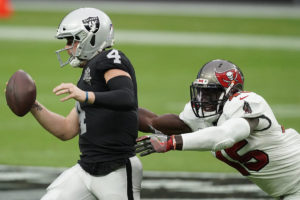
Bucs ILB Devin White and Raiders QB Derek Carr – Photo by: USA Today
The Raiders have tanked Carr’s trade value considerably since benching him late in the season. That move, combined with the automatic trigger on February 15th that would fully guarantee all of his $32.9 million salary in 2023 along with $7.5 million of his 2024 salary, mean that Vegas has little to no leverage.
They will cut Carr before the trigger if they can’t find a trade partner. That will depress any offer they receive. The Bucs would most likely be competitive with an offer of a third-rounder in 2023 and a third-rounder in 2024.
The difficulty for the Bucs in trading for Carr is in accounting for his contract at the moment of the trade’s execution. The team would have to have $33 million in available cap room to take on Carr. They could reduce his cap hit once he is acquired, but they have to have the room up front.
Going back to all of the moves I detailed at the outset of this article, the Bucs still would not have enough room to absorb the Las Vegas lame duck signal-caller. They would need to make additional moves such as cutting Russell Gage with a post June 1 designation, as well as fully restructuring the contracts of outside linebacker Shaq Barrett and center Ryan Jensen. Doing all of this would allow them to squeak Carr under the cap.
At that point the Bucs could restructure Carr’s deal and lower his cap hit down to $7,612,000. This would free up $25,388,000 for the team to make additional moves to help round out the roster around Carr. Keep in mind these moves would push dead cap charges down the line while also partially guaranteeing some of Carr’s 2024 salary.
At that point, his cap hits for 2024 and 2025 would move to $48.367 million and $47.667 million, respectively. It would also mean if the Bucs wanted to cut Carr following the 2023 season they would have to absorb a dead cap hit of $32.888 million in 2024.
There Are No Good Options For The Bucs
Both of the above options are cost prohibitive, but not impossible. With the free agent market showing a dearth of talent, the Bucs are likely to be looking at either trading up in the draft to land their future face-of-the-franchise or rolling with a bridge quarterback (Trask anyone?) for at least one season.
Josh Queipo joined the Pewter Report team in 2022, specializing in salary cap analysis and film study. In addition to his official role with the website and podcast, he has an unofficial role as the Pewter Report team’s beaming light of positivity and jokes. A staunch proponent of the forward pass, he is a father to two amazing children and loves sushi, brisket, steak and bacon, though the order changes depending on the day. He graduated from the University of South Florida in 2008 with a degree in finance.

